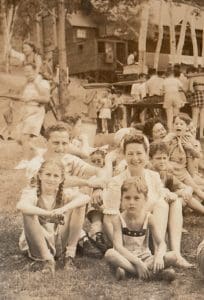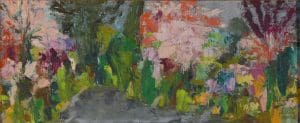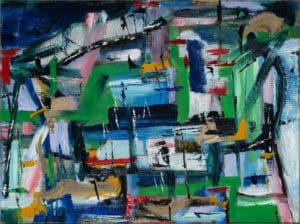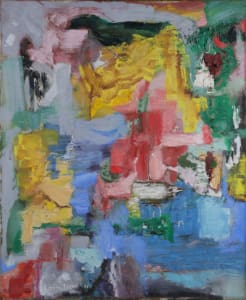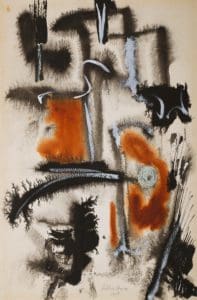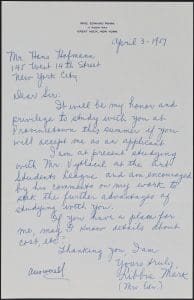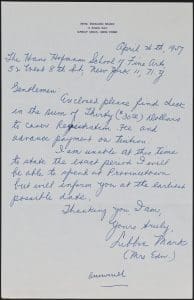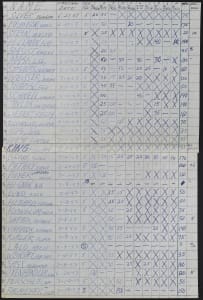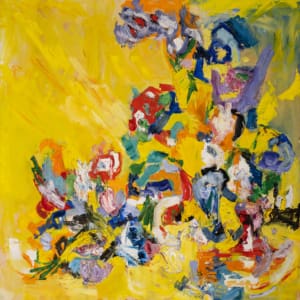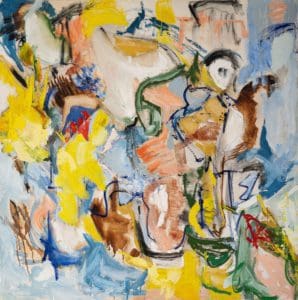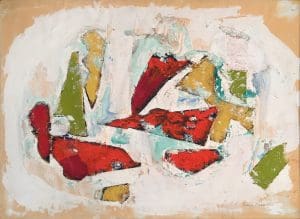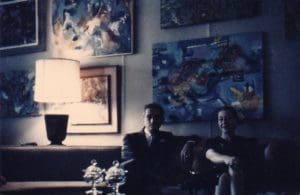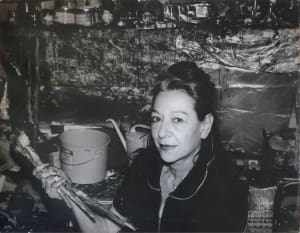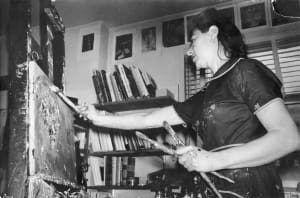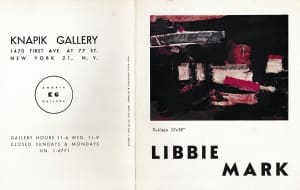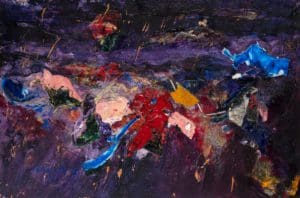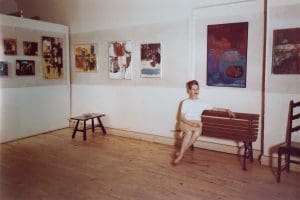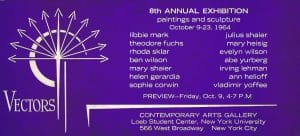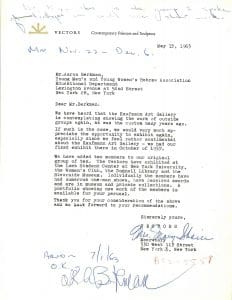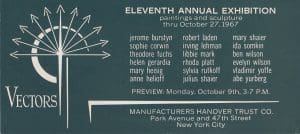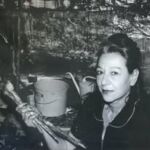The Vectors of Libbie Mark
© Jennifer Uhrhane
After Reuben graduated from Great Neck Senior High School in 1956, Mark and her husband tried living in New York City between 1956 and 1958, when she was enrolled in courses at the Art Students League. They stayed in a 15 East 63rd Street apartment and spent a winter at the Mayflower Hotel at 15 Central Park West.8
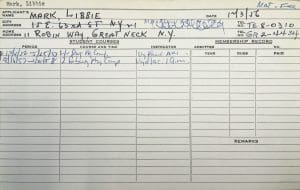
Fig. 5. Libbie Mark’s Art Students League registration card. Student Registration Records, Archives of the Art Students League of New York.
At the Art Students League, Mark took classes with Vytlacil (fig. 5), and likely met many other influential teachers, including his prominent colleagues Will Barnet, Edwin Dickinson, George Grosz, William Zorach, and others on staff at that time.9 Vytlacil was educated in the United States and Europe, Hofmann’s student and assistant in Munich in the 1920s, and taught at the Art Students League mainly between 1946 and 1978.10 Mark attended Vytlacil’s “Life Drawing, Painting and Composition” classes from December 1956 to May 1957, presumably five mornings per week at a cost of $32 per month, and from September 1957 to March 1958 at $34 per month.11, 12 A number of Mark’s pieces, some dated in the late 1950s and others that stylistically appear to be from the same period, show her increasing interest and skill in abstraction. Two untitled paintings on canvas, both dated 1956 (figs. 6 and 7, Inv. nos. 24R and 33JM) feature bold horizontal and vertical swaths of thick paint in a wide-ranging color palette. Two 1958 works on paper, one named for Mark’s granddaughter (fig. 8, Inv. no. 21J), and the other untitled (fig. 9, Inv. no. 03M), feature expressive inky brushstrokes. Further research needs to be done on Mark’s other works completed around the time of her studies with Vytlacil.13
Mark’s connections and courses at the Art Students League led her to the Hans Hofmann School of Fine Arts in Provincetown, Massachusetts, in the summer of 1957.14 Beginning around 1898, Hofmann studied with a number of individual artists in Germany and at graphic arts schools,15 then opened his own School of Fine Art in Munich in 1915.16 Well-established as an artist and teacher, he moved to New York in 1932 and briefly taught at the League before again establishing his own school. It was first located in New York, then very soon after also in Provincetown.17 On April 3, 1957, Mark wrote to Hofmann,
Dear Sir:
It will be my honor and privilege to study with you at Provincetown this summer if you will accept me as an applicant.
I am at present studying with Mr. Vytlacil at the Art Students League and am encouraged by his comments on my work to seek the further advantages of studying with you…18 (fig. 10)
Hofmann must have responded with an acceptance letter, as Mark followed up with a second letter dated April 26, 1957, in which she enclosed $30—her registration fee of $5 and advance tuition payment of $25—and stated that,
I am unable at this time to state the exact period I will be able to spend at Provincetown but will inform you at the earliest possible date.
Thanking you, I am,
Yours truly,
Libbie Mark
(Mrs. Edw.) (fig. 11)
In between her courses with Vytlacil, Mark attended Hofmann’s final summer session in Provincetown,19 from July 1, 1957 through the end of August, at a cost of approximately $170 (fig. 12).20 Mark’s bright floral-like untitled abstract, in an unusual square format, inscribed “1957–HH” on the verso, was likely painted in Hofmann’s class (fig. 13, Inv. no. 50JM). We can assume another square format work from the same year, in a similar size and color palette, was also painted with Hofmann (fig. 14, Inv. no. 46JM). Mark clearly made an impression on her teacher that summer: her archive also contains a copy of Frederick S. Wight’s 1957 monograph Hans Hofmann, which is inscribed “to Libbie Mark / Provincetown | Mass / Hans Hofmann” on the title page (fig. 15).
A story on Hofmann and his school was also published in Life in 1957; the article quoted Vytlacil on Hofmann’s influence as a teacher.21 Mark likely enrolled in just this one course with Hofmann in Provincetown, given the timing of his teaching retirement. He closed his New York school in 1956, and Mark’s 1957 letter clearly indicates they had no prior contact.22 Mark’s classmates included Red Grooms and Helen Levitt;23 many other artists such as Milton Avery, Adolph Gottlieb, Allan Kaprow, and Mark Rothko also worked in Provincetown that summer.24 Mark and her family continued to spend summers on the outer Cape in the oldest continuous artist colony in the United States, from the late-1950s until 1971 (fig. 16). She undoubtedly benefited from and enjoyed being a part of such a vibrant creative community.
Following their summer in Provincetown, in 1958 the Marks rented an apartment at 35 East 85th Street, fully transitioning from Great Neck. Their daughter Judith and her husband Michael Tanur had relocated to Brooklyn, also that year (fig. 17). In 1962, the Marks moved to 176 East 71st Street, renting a separate painting studio nearby. A separate unit in their building on East 71st later served as her workspace, but they installed metal screens on their living room wall where she could easily rotate displays of her paintings (fig. 18). Mark’s archive contains portraits made in her studio, signed and stamped with the photographer’s name and address (figs. 19 and 20). Also located at 35 East 85th Street, and known as “Dena,” Dinah Rubinstein photographed numerous other artists, including Dorothy Dehner, Willem De Kooning, Edwin Dickinson, Charles “Red” Grooms, Chaim Gross, Robert Motherwell, Louise Nevelson, George Segal, Raphael Soyer, Jack Tworkov, and Andy Warhol.25
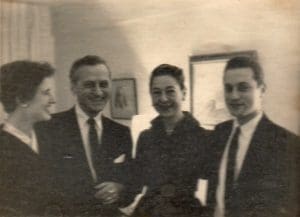
Fig. 17. Michael Tanur, left to right: Judith Tanur, Edward, Libbie, and Reuben Mark, in the Tanurs’ Brooklyn apartment, 1958. Judith and Michael Tanur Collection.
According to her family, surprisingly Mark had just one solo show. Libbie Mark: Paintings and Collages opened in May 1962 at Knapik Gallery (fig. 21). The exhibition is chronicled in brochures, clippings, photographs, and a checklist.26 Mark had begun using collaged elements in a few pieces from the mid–1950s (the earliest documented so far is dated 1956, see fig. 6) but by the early 1960s she almost exclusively incorporated paint and other materials on paper, Masonite, or canvas, to build up the heavily textured surfaces like the works in this show (fig. 22, Inv. no. 34JM). Mark was among many artists working with collage during this time, creating “the inevitable expression…of the constantly decomposing and recomposing experience of the city.”27 ARTnews, France-Amérique, Manhattan East, New York Herald Tribune, and New York Journal-American reviewed the show.28 In ARTnews, Jill Johnston described some of the works on view at Knapik:
One is a high-toned noonday picture dominated by a central red that tornadoes up into yellow, surrounded by green and blue-grey. Another abstraction has a midnight carnival flavor in its deep purples and blues sparked with red and surprises of veiny greens.29
Jane Jaffe, from Manhattan East, wrote:
Considering the technique used in many of these collages, Miss Mark’s spontaneity is all the more remarkable…These paintings are assuredly the work of a mature, imaginative, and dynamic artist.30
Nathan Rabin, who worked extensively for artists and collectors, such as William N. Copley, Lucien Goldschmidt, Claes Oldenburg, and Serge Sabarsky,31 photographed Mark at her exhibition (figs. 23 and 24). These photographs have been especially helpful in identifying at least ten works in the Libbie Mark Provincetown Fund collection. Eleven additional pieces not in the photographs match the pricelist descriptions (fig. 25).32
Mark followed this solo exhibition with participation in a number of group shows that would prove very significant for her artistic career. In her archive, I discovered an exhibition postcard from October 1964, which documented Mark’s membership in the Vectors artist group (fig. 26). The postcard, for their 8th Annual Exhibition of Paintings and Sculpture held at the Contemporary Arts Gallery at New York University, led me to research this remarkably understudied but fascinating group.
So far, my research has produced a Vectors membership list spanning ten years that consists of twenty-three artists, including two married couples. Despite turnover, the group featured strong female representation. Notably, seven of the original 1957 roster of ten were women (fig. 27), and in eight of nine exhibitions with listed participants, over fifty percent were female.33 This is especially meaningful at a time when women were not as recognized or given as much exposure as men (a recurring problem). Vectors members between 1957 and 1967 were:
Sophie [Sophia Miller] Corwin (1915–1999)
Sidney Delevante (1894–1984)
Theodore Fuchs (1911–1999)
Helen Gerardia (1903–1988)*
Mary Heisig (1913–1966)*
Anne [Graile] Helioff [Hirschberg] (1910–2001)
Robert Laden (1931–2019)
Irving Lehman (1900–1983)
Frances Manacher (1914–2013)*
Libbie Mark (1905–1972)
Sylvia Rutkoff (1919–2011)
Julius Shaier (1910–2000)
Mary Shaier (1905–1971)*
Rhoda Sklar [Platt] (1914–2004)*
Ida Somkin (1906–2000)
Miriam Sommerburg (1900–1980)*
Ethel Stein (1917–2018)
John Stoehrer (1910–1999)
Ben Wilson (1913–2001)*
Evelyn O. [Perlman] Wilson (1915–2006)*
Vladimir Yoffe (1911–1997)*
Abe Yurberg (1912–2013)*
The Vectors’ first exhibition was in October 1957 at the 92nd Street Y (fig. 30).42 The most recent I have identified so far was their Eleventh Annual Exhibition in October 1967 (fig. 31) at the Manufacturers Hanover Trust bank, which collected art and regularly hosted art exhibits. The catalog stated:
In 1957 a group of artists with mutual respect for each other’s creativity decided to exhibit together. They gave themselves the name, “Vectors”—directional guides to various modes of expression from figurative to non-objective work.43
According to its catalog (fig. 32), the Vectors presented fourteen previous shows.44 I have documented twelve including this one. Like other collectives before and since, the Vectors utilized different kinds of spaces as accessible alternatives to the traditional gallery. The group revisited venues known for their arts programming, among them the 92nd Street Y45 and the New York Public Library’s Donnell Library Center.46
One of the most unexpected finds to result from my research on Mark was the discovery of a Grace Hartigan painting in her family’s collection. Supposedly, Mark and her husband bought Hartigan’s Venetian Self-Portrait (fig. 33) to support their artist friend during a stressful financial period in Hartigan’s life. The work was exhibited in her third solo show at Tibor de Nagy Gallery in March 1953.47 De Nagy, an economist, worked at Manufacturers Hanover Trust while running the gallery.48 Coincidentally, Deckoff was the exhibition’s reviewer for ARTnews, praising Hartigan’s “new imagery that breaks through seething brushwork and overlaid color with a power that combines earthiness with an almost cynical mystery.”49
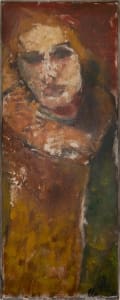
Fig. 33. Grace Hartigan, Venetian Self-Portrait, 1952. Oil on canvas, 40 x 16 in. Judith and Michael Tanur Collection. ©Grace Hartigan Estate.
Hartigan followed the gallery’s attempted sales of her painting after she delivered it in October 1952: “Brought the other self portrait—‘Venetian Self-Portrait’ & Maharaja #2 to the gallery—John [Bernard Myers, gallery co-owner] & Fairfield [Porter] were terribly enthusiastic over the self port…”50 In December 1952, Alfred H. Barr Jr., director of the Museum of Modern Art (MoMA), considered acquiring it and two of her other paintings for the collection.51 The purchase apparently fell through, as Hartigan wrote in a May 18, 1953 journal entry about another buyer:
I’m waiting to hear from John [Bernard Myers] whether Gertrude Fisher has decided to buy Venetian Self-Portrait—she had it on approval for the weekend. I’m down to thirty dollars, and if she doesn’t take it I’ll have to look for a job to-morrow [sic].52
A couple days later, on May 20, 1953, she wrote: “In a terrible state of melancholy to-day [sic]. Gertrude Fisher returned the picture and I must get a job.”53 Undated records show that “Mr. and Mrs. Marks [sic]” purchased the painting.54
Unlike many other female artists, due to the support of her husband Edward, Mark was able to paint, take classes, and participate in exhibitions, free of financial concerns. His assistance was not just monetary however. Edward saw himself as a provider of intangible things as well: he actively encouraged Mark’s artistic career and it was vital to him that she should be happy. A corporate financial executive, he even learned how to stretch canvas and make picture frames. Mark’s basement studio in Great Neck was set up so she could paint and be available for her children until they went to college, when her output escalated. The Marks relocated so she could be closer to the New York art scene. They rented city studio space. They invested in prestigious art classes. Their summers in Provincetown were “for her.” Possibly, without Edward’s strong belief in Mark, she would not have produced this volume of work. Her personal situation provided an opportunity, but to be clear: this was not a case of a comfortable housewife with a hobby.
The extent and duration of Mark’s artistic activity, the quality of the work, the clear drive, and the related life decisions that made it happen, demonstrate her serious commitment to her art. From the Great Neck Adult Education fine arts program to the Art Students League to Provincetown, Mark created art in some of the United States’ most significant artistic communities. She continued to spend summers in Provincetown until 1971 and painted until her death in 1972. Mark succumbed to lung cancer at age 66 in New York, NY, leaving well over a hundred artworks in her family’s possession, and countless others in private collections. My hope is that this initial investigation into this underrecognized but important artist will also inspire further study and exhibition of her work. In the meantime, I will continue on my trajectory.
Jennifer Uhrhane has worked in curatorial, collections management, and registrarial roles in museum, corporate and private art collections for almost 20 years. She also consults with artists and families regarding art collection/archive documentation, management and estate planning. Uhrhane holds a BFA in photography from Rhode Island School of Design, a Certificate in Museum Studies and Administration from Tufts University, and an MA in Art History from Boston University.
Endnotes
1. All of the information about Mark, unless otherwise cited, was provided by Mark’s daughter and son, and obtained through e-mail messages to and phone conversations with the author between June 2016 and March 2019.
2. Helen A. Harrison, “The Lively Arts; Great Neck Hails Louise Nevelson,” April 8, 1984, New York Times, LI17.
3. Andrew D. Hottle, The Art of the Sister Chapel: Exemplary Women, Visionary Creators, and Feminist Collaboration (Burlington, VT: Ashgate Publishing, Ltd., 2014), 22.
4. Ibid., 95.
5. The Great Neck Library, Great Neck School System, and Great Neck Historical Society do not have GNAE enrollment or other records. Margery Chodosch, Interim Head, Reference Department, Great Neck Library, Great Neck, NY, e-mail message to author, September 29, 2017. Samantha Tarantola, Director of Community Education, Great Neck Public Schools, Great Neck, NY, e-mail message to author, October 11, 2017. Leila Mattson, Vice President for History, Great Neck Historical Society, Great Neck, NY, e-mail message to author, August 16, 2018.
6. For more on these artists and their time at GNAE, see Helen A. Harrison, “The Boldness and Delicacy of Betty Holliday,” March 18, 1979, New York Times, LI16; Mary Gabriel, Ninth Street Women: Lee Krasner, Elaine de Kooning, Grace Hartigan, Joan Mitchell, and Helen Frankenthaler: Five Painters and the Movement That Changed Modern Art (New York: Little, Brown and Company, 2018), 647; and Ted Leigh, ed., Material Witness: The Selected Letters of Fairfield Porter (Ann Arbor: University of Michigan Press, 2005), 181.
7. Larry Rivers’s papers do not include any documentation of his teaching at GNAE. Marvin J. Taylor, Director, Fales Library and Special Collections, New York University, e-mail message to author, October 9, 2017. However, there are newspaper articles referencing Rivers’s GNAE courses. See, for example, outdoor painting class in “Nassau News Briefs,” Newsday, March 30, 1956, 77, and Thursday class in “Artist Who Got ‘Ohs’ on LI Stirs ‘Ahs’ in NY,” Newsday, December 24, 1956, 7. I am hoping to do further research in Deckoff’s papers to see if I can find more on the GNAE fine arts program.
8. Confirmed by Mark’s family, addresses per Student Registration Records, Archives of the Art Students League of New York.
9. Course catalogue for 81st Regular Session, “Instructors 1956–1957,” Art Students League: September 17, 1956 to May 25, 1957, 3, and course catalogue for 82nd Regular Session, “Instructors 1957–1958,” Art Students League: September 16, 1957 to May 27, 1958, 3, Archives of the Art Students League of New York.
10. “Vaclav Vytlacil: Artist Biography,” Smithsonian American Art Museum, accessed February 9, 2019, https://americanart.si.edu/artist/vaclav-vytlacil-5185.
11. Art Students League Student Registration Records; course catalogue for 81st Regular Session, “Tuition and Schedule of Classes, 1956–1957,” Art Students League: September 17, 1956 to May 25, 1957, 10; and course catalogue for 82nd Regular Session, “Tuition and Schedule of Classes, 1957–1958,” Art Students League: September 16, 1957 to May 27, 1958, 10, Archives of the Art Students League of New York.
12. It is important to note the cost of these classes. 6 weeks in 1957 at $32 per = $192. In 2019 dollars this is approximately $1,750, using the savings.org inflation calculator, which utilizes the United States Bureau of Labor Statistics’ Consumer Price Index data to calculate values. 7 weeks in 1958 at $34 per = $238. In 2019 dollars this is about $2,100.
13. The majority of Mark’s works that are dated were completed after 1958, so further research is needed to pinpoint which were created while at the Art Students League.
14. The Art Students League-Provincetown connection is well documented. See for example, Rhoda Rossmoore, Tony Vevers, Ronald G. Pisano, et al., The League at the Cape 1993: An Historical Exhibition Sponsored by the Art Students League and the Provincetown Art Association and Museum, August 14, 1993 to September 20, 1993 (Provincetown, MA and New York, NY: Museum Galleries of the Provincetown Art Association and The Art Students League, 1993).
15. “Hans Hofmann Biographical Chronology: 1880−1899,” Renate, Hans, and Maria Hofmann Trust, accessed February 13, 2019, http://www.hanshofmann.org/1880-1899. “Hans Hofmann Biographical Chronology: 1900−1909,” Renate, Hans, and Maria Hofmann Trust, accessed February 13, 2019, http://www.hanshofmann.org/1900-1909.
16. “Hans Hofmann Biographical Chronology: 1900−1919,” Renate, Hans, and Maria Hofmann Trust, accessed February 13, 2019, http://www.hanshofmann.org/1910-1919.
17. “Hans Hofmann Biographical Chronology: 1930−1939,” Renate, Hans, and Maria Hofmann Trust, accessed February 13, 2019, http://www.hanshofmann.org/1930-1939.
18. Mark’s registration, attendance, and financial paperwork as well as correspondence with Hofmann are in “Hans Hofmann papers, [circa 1904]–2011, bulk 1945–2000,” Archives of American Art, Smithsonian Institution, accessed March 27, 2018, https://www.aaa.si.edu/collections/hans-hofmann-papers-5966.
19. “Hans Hofmann Biographical Chronology: 1950−1959,” Renate, Hans, and Maria Hofmann Trust, accessed February 13, 2019, http://www.hanshofmann.org/1950-1959.
20. Using the savings.org inflation calculator, $170 in 2019 dollars is about $1,550. Additional costs would have been their two months or more of accommodations, other living expenses.
21. “A Master Teacher: Hofmann influences three decades of U.S. Art,” Life, April 8, 1957, 70.
22. Hofmann did hold one small critique in the summer of 1958. “Hans Hofmann Biographical Chronology: 1950−1959.” Further research is needed to determine if Mark attended this session.
23. Other students’ registration, attendance, and financial paperwork as well as correspondence with Hofmann are in “Hans Hofmann papers.”
24. Melissa Renn, “Via Provincetown: The American Avant-Garde on Cape Cod, 1913−1966,” in A Century of Inspiration: Provincetown Art Association and Museum (Provincetown, MA: Provincetown Art Association and Museum, 2015), 89, 92.
25. See Rubinstein’s photographs in the Archives of American Art, “[Photographs of artists taken by Dena], [1964–1975],” accessed February 9, 2019, https://www.aaa.si.edu/collections/photographs-artists-taken-dena-11137; in the Art Institute of Chicago collection, and in an Albright Knox Gallery exhibition, “The Brave Buffalo: Abstract Expressionism and the City,” accessed March 19, 2020, https://www.albrightknox.org/art/exhibitions/brave-buffalo-abstract-expressionism-and-city.
26. Archival materials for the artist are held by the Libbie Mark Provincetown Fund Collection.
27. Jed Perl, New Art City: Manhattan at Mid-Century (New York, NY: Knopf, 2005), 281, 284.
28. All review clippings are held in the Libbie Mark Provincetown Fund Collection: J. J. (Jill Johnston), “Reviews and previews: New names this month,” ARTnews 61 (May 1962): 18; Jane Jaffe, “News and Views of the Galleries: Mark at Knapik,” Manhattan East, May 24, 1962, 4; L. E. Levick, “Gallery Guide,” New York Journal-American, May 19, 1962, 7; Saint-Evremond, “Libbie Mark chez Knapik,” France-Amérique, June 17, 1962, 15; John Gruen, “Art Tour,” New York Herald Tribune, May 19, 1962, 11.
29. Johnston.
30. Jaffe.
31. Lisa Coldiron, Image Specialist for Special Projects, Image Collections, National Gallery of Art, e-mail message to author, February 25, 2019. The National Gallery of Art Library’s Image Collections contain 27,000 negatives and 1,300 photographs by Rabin. “Featured Photographers: Nathan Rabin,” National Gallery of Art, accessed January 30, 2019, https://www.nga.gov/research/library/imagecollections/photographers-and-campaign-organizers.html.
32. Knapik Gallery checklist, Libbie Mark Provincetown Fund Collection. Works pictured include inv. nos.: 02J, 02R, 06M, 07R, 09R, 10R, 16J, 23R, 24JM, and 36JM. Works matching the checklist include: 01R, 05R, 08R, 09M, 10J, 11R, 20J, 22JM, 34JM, 38JM, and 47JM. All are Libbie Mark Provincetown Fund Collection.
33. Postcard, Vectors Art Exhibition, October 7–31, 1957, YMHA Kaufmann Auditorium (now 92nd Street Y), New York, NY, Rhoda Sklar Platt Papers, Collection Judith and Selina Trepp; Women’s City Club of New York, “Work by the Vectors, December–January 1959,” On the Agenda XVI, no. 2 (December 1958): 2, Records of the Women’s City Club of New York, Inc., d.b.a. Women Creating Change, 1915-2011, Box 61, Folder 4, Archives & Special Collections, Hunter College Libraries, Hunter College of the City University of New York, New York City; postcards: Vectors 6th Annual Exhibition, January 13–February 3, 1963, Riverside Museum, and Vectors 7th Annual Exhibition, November 22–December 6, 1963, YMHA Kaufmann Auditorium (now 92nd Street Y), Irving Lehman Papers, Special Collections Research Center, Syracuse University Libraries; postcard, Vectors 8th Annual Exhibition; postcard, Vectors Exhibition of Contemporary Painting and Sculpture, November 22–December 21, 1964, Spencer Memorial Gallery, Anne Helioff artist file, Woodstock Artists Association & Museum Archives, Woodstock, NY; postcards: Vectors Paintings and Sculpture, May 3–24, 1959, Riverside Museum, and Vectors Eleventh Annual Art Exhibition, October 9–27, 1967, Manufacturers Hanover Trust, Ben and Evelyn Wilson Papers, George Segal Gallery, Montclair State University, Montclair, NJ.
34. Postcards: Vectors 6th Annual Exhibition, Vectors 7th Annual Exhibition, Vectors 8th Annual Exhibition, Vectors Exhibition of Contemporary Painting and Sculpture (1964), and Vectors Eleventh Annual Art Exhibition.
35. Institutional collections include: 92nd Street Y Archives, New York, NY; Mary Heisig artist file, Brooklyn Museum of Art Library Collections. BMA artist files; Records of the Women’s City Club of New York, Inc., d.b.a. Women Creating Change, Archives & Special Collections, Hunter College Libraries, Hunter College of the City University of New York, New York City; Ben and Evelyn Wilson Papers, George Segal Gallery, Montclair State University, Montclair, NJ; Sophie Corwin, Sidney Delevante, Theodore Fuchs, Helen Gerardia, Mary Heisig, Anne Helioff, Irving Lehman, Frances Manacher, Ben Wilson, and Evelyn Wilson Art and Artist Files, Smithsonian American Art and Portrait Gallery Library, Smithsonian Libraries, Washington, DC; Irving Lehman papers, Special Collections Research Center, Syracuse University Libraries; and Anne Helioff artist file, Woodstock Artists Association & Museum Archives, Woodstock, NY.
36. Personal correspondents include: Mark’s daughter Judith Tanur and son Reuben Mark, as well as Laden’s daughter Nina Laden, Manacher’s daughter Susan Lyons, Rutkoff’s nephew Stephen Lesser, the Shaiers’ daughter Ellen Shire, Sklar’s daughter Judith Trepp and granddaughter Selina Trepp, Somkin’s son Steven Somkin, Stein’s son Carl Stein, the Wilsons’ daughter Joanne Jaffe, and Yurberg’s daughter Emily Yurberg.
37. This research is ongoing, especially to determine timeframes, in conversations with Ellen Shire and Judith Trepp via e-mail messages to author, February 2018 to the present.
38. “Ethel Stein, Who Created Intricate Textile Art, Dies at 100,” New York Times, accessed September 11, 2018, https://www.nytimes.com/2018/03/12/obituaries/ethel-stein-who-created-intricate-textile-art-dies-at-100.html.
39. Jerome Burstyn, Ida Somkin, Ben Wilson, Evelyn Perlman Wilson, and Vladimir Yoffe worked for the WPA. “Transcript of Employment: Burstyn, Jerome,” Francis V. O’Connor papers, 1920-2009. Archives of American Art, Smithsonian Institution; “From the Studio: Ida and Eugene Somkin duo exhibition,” The East Hampton Star, accessed September 6, 2018, http://easthamptonstar.com/Archive/1/Studio-33; “Biography,” Ben Wilson American Artist, accessed January 19, 2018, https://benwilsonamericanartist.org/bio/; “Fellow WPA Artist Evelyn Perlman, Ben’s Future Wife,” Ben Wilson American Artist, accessed January 19, 2018, https://benwilsonamericanartist.org/portfolio/scrapbook/fellow-wpa-artist-evelyn-perlman-bens-future-wife/; “Vladimir Yoffe,” New Deal Art Registry, accessed January 20, 2018, https://www.newdealartregistry.org/artist/Yoffevladimir/#.
40. Capricorn Gallery exhibited Sophie Corwin, Anne Helioff, and Robert Laden. Sophie Corwin and Anne Helioff, Art and Artist Files; “What’s New in Art,” New York Times, December 18, 1966, x36, ProQuest Web. Knapik Gallery exhibited Sidney Delevante, Irving Lehman, Libbie Mark, and Ben Wilson. Artist resume, Sidney Delevante Art and Artist Files; Artist resume, Irving Lehman Papers; Exhibition announcement, Libbie Mark: Paintings and Collages; “Exhibitions,” Ben Wilson American Artist, accessed January 19, 2018, https://benwilsonamericanartist.org/exhibitions/. Harry Salpeter Gallery exhibited Irving Lehman, Frances Manacher, Ben Wilson, and Abe Yurberg. Artist resume, Irving Lehman Papers; Frances Manacher Art and Artist Files; “Exhibitions,” Ben Wilson American Artist; “Abraham Yurberg,” Ward-Nasse Gallery, accessed July 15, 2016, http://www.wardnasse.org/2200p179.htm.
41. Sophie Corwin, Sidney Delevante, Theodore Fuchs, Helen Gerardia, Mary Heisig, Anne Helioff, Irving Lehman, Libbie Mark, Sylvia Rutkoff, Mary Shaier, Ida Somkin, and John Stoehrer attended Art Students League. Student Registration Records, Archives of the Art Students League of New York. Sophie Corwin, Sidney Delevante, Helen Gerardia, Anne Helioff, Robert Laden, Libbie Mark, and Mary Shaier attended Hans Hofmann School of Fine Arts. Sophie Corwin, Anne Helioff, Libbie Mark, and Mary Shaier: “Partial List of Hofmann Students Per Era,” Color Creates Light: Studies with Hans Hofmann, accessed July 15, 2016, http://www.colorcreateslight.com/studentsccl.html; Delevante Art and Artist File; Gerardia “Line Form Color,” Blanton Museum of Art exhibition, accessed February 28, 2019, https://blantonmuseum.org/rotation/line-form-color/; Robert Laden resume, Collection Nina Laden. Irving Lehman, John Stoehrer, and Ben Wilson attended National Academy of Design. Lehman Art and Artist File; “John Stoehrer, 1910-1999 [obit],” Daily Star (Oneonta, NY) via Ancestry.com, accessed October 9, 2017, https://www.ancestry.com/boards/surnames.stoehrer/2/mb.ashx; “Biography,” Ben Wilson American Artist.
42. They had a secretary, a logo, and stationery. Mary Shaier, Vectors secretary, letter to Aaron Berkman, 92nd Street Y Education Department, May 13, 1963, 92nd Street Y Archives, New York, NY.
43. Catalog, Vectors Eleventh Annual Art Exhibition, October 9–27, 1967, Manufacturers Hanover Trust, Ben and Evelyn Wilson Papers.
44. Ibid.
45. Exhibited twice, see postcards: Vectors Art Exhibition (1957) and Vectors 7th Annual Exhibition. See also “140 years of cultural programming,” 92nd Street Y, accessed January 31, 2018, https://www.92y.org/about-us.aspx.
46. Exhibited three times, see show listings: “Exhibitions in Galleries and Museums this Week,” New York Times, September 17, 1961, X23, ProQuest Web; “Art Shows,” New York Times, July 5, 1964, 16X, ProQuest Web; and “What’s New in Art,” New York Times, December 11, 1966, 192, ProQuest Web. The library, which also had a purposefully substantial art book collection, opened in 1955 across from the Museum of Modern Art and the former Museum of Contemporary Crafts, and behind the Whitney Museum of American Art. Sanka Knox, “Donnell Library to Open Tuesday,” New York Times, December 7, 1955, 78, ProQuest Web.
47. Cathy Curtis, Restless Ambition: Grace Hartigan, Painter (New York, NY: Oxford University Press, 2015), 107. At this time, she exhibited as George Hartigan. Gallery checklist in William T. La Moy and Joseph P. McCaffrey, eds., The Journals of Grace Hartigan, 1951–1955 (Syracuse, NY: Syracuse University Press, 2009), 76.
48. Roberta Smith, “Tibor de Nagy, 85, Gallery Owner Who Helped Cultivate 50’s Artists,” New York Times, December 28, 1993, 20.
49. B. H. (Betty Holliday), “George Hartigan,” ARTnews 52 (April 1953): 39.
50. La Moy and McCaffrey, The Journals of Grace Hartigan, 47.
51. Ibid., 63. MoMA’s final acquisition choice was Persian Jacket, donated by George Poindexter in June 1953. See Ibid., 85.
52. Ibid., 82.
53. Ibid.
54. Annotated gallery checklist. Ibid., 76.
55. The Art Students League has no registration records for Hartigan. Stephanie Cassidy, Manager, Editorial Services, LINEA, Art Students League of New York, e-mail message to author, December 5, 2018.
56. Gabriel, Ninth Street Women, 276, 288.
57. The dramatic events surrounding her quitting are described in Ibid., 405.


